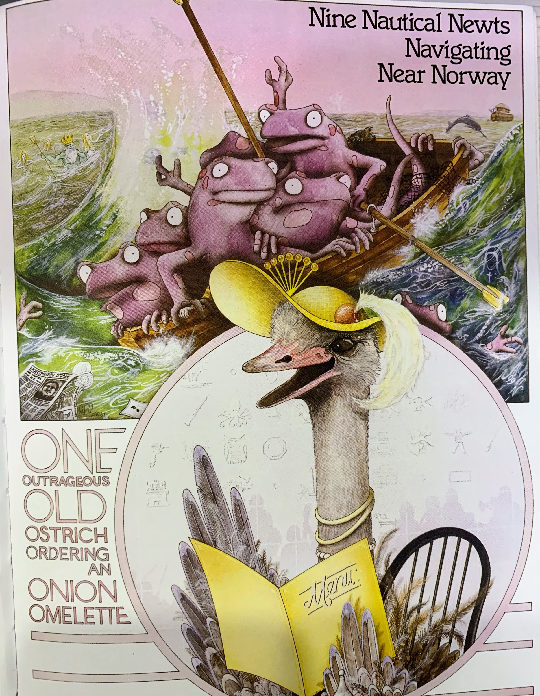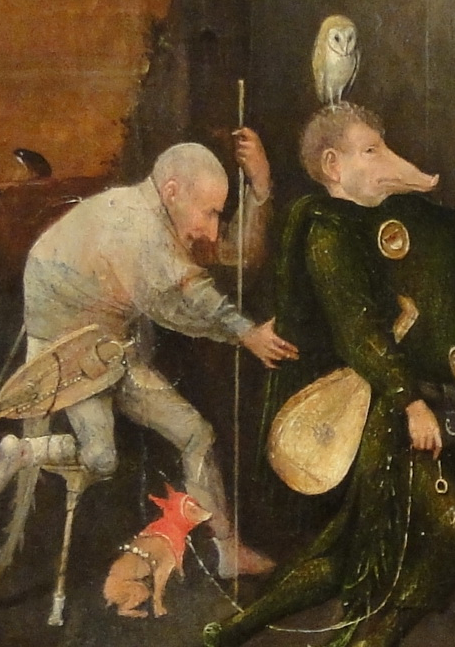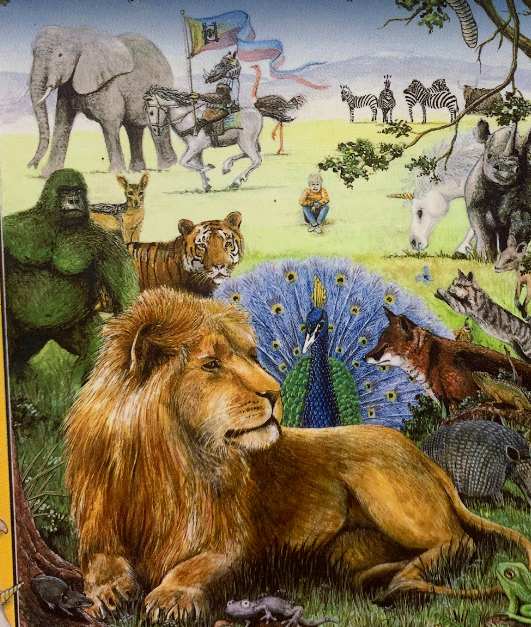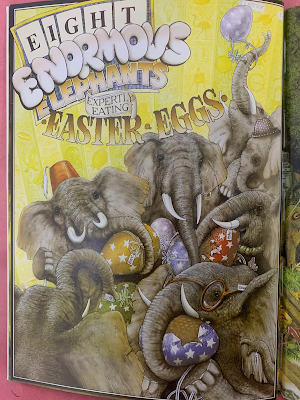Tam multa, ut puta genera linguarum sunt in hoc mundo: et nihil sine voce est.
Sunday, June 30, 2024
Dreaming in black and white
Saturday, June 29, 2024
Zinc Zeppelin
Retraction
Another point in favor of democracy is that mass elections do tend to ensure that kings meet certain very basic standards of competence and normality. Of course many democratically elected leaders are scoundrels, and some of them are relatively incompetent — but I feel pretty safe in saying that the U.S. has never elected a president with a two-digit IQ and never will. Nor do 12-year-olds win elections, or people with serious mental illnesses.
We regret the error.
Friday, June 28, 2024
Gryphon + Mock Turtle = Cherubim
Thursday, June 27, 2024
Nautical Newts
Why should no man starve on the deserts of Arabia?Because of the sand which is there.How came the sandwiches there?The tribe of Ham was bred there and mustered.
Let us take the Book of Mormon, which a man took and hid in his field, securing it by his faith, to spring up in the last days, or in due time; let us behold it coming forth out of the ground, which is indeed accounted the least of all seeds, but behold it branching forth, yea, even towering, with lofty branches, and God-like majesty, until it, like the mustard seed, becomes the greatest of all herbs. And it is truth, and it has sprouted and come forth out of the earth, and righteousness begins to look down from heaven, and God is sending down His powers, gifts and angels, to lodge in the branches thereof.
And the Lord said, If ye had faith as a grain of mustard seed, ye might say unto this sycamine tree, Be thou plucked up by the root, and be thou planted in the sea; and it should obey you (Luke 17:6).
Monday, June 24, 2024
The horrible hairy homeward-hurrying hogs of Hieronymus
Running along the midnight beach in the direction of the Martello tower and the holiday camp, -- running along the water's edge so that the incoming tide washed away its footprints, -- swerving and feinting, running for its life, there came a full-grown, large-as-life ostrich.
I will lift up mine hand to the Gentiles, and set up my standard to the people; and they shall bring thy sons in their arms, and thy daughters shall be carried upon their shoulders (1 Ne. 21:22).
[Joseph's] glory is like the firstling of his bullock, and his horns are like the horns of unicorns: with them he shall push the people together to the ends of the earth: and they are the ten thousands of Ephraim, and they are the thousands of Manasseh (Deut. 33:17).
Sunday, June 23, 2024
I think I found a book formerly owned by Donald Trump!
GAEL
Recent sync activity has centered around Animalia by Graeme Base, which is an alphabet book. I was thinking how funny it was to be taking an alphabet book so seriously, and then I remembered that I was well within Mormon tradition in so doing, given Joseph Smith's Grammar and Alphabet of the Egyptian Language. This is commonly referred to (by those few who do refer to it) as "the GAEL," which I guess makes the language therein described -- clearly "Egyptian" in name only -- GAELic.
"The Gael" is also the name of that tune from The Last of the Mohicans. Just in case it's not playing in your head already, here's a little help:
My interest in Animalia has been focused on the G and L pages -- two of the letters in GAEL -- both of which have some "Gaelic" themes. The L page includes a leprechaun, while the main subject of the G page is green gorillas. Green is the symbol of Ireland, and Punch cartoons used to portray the stereotypical Irishman as "Mr. G-O'Rilla." The Irish poet William Butler Yeats has recently been associated with Pharaoh's butler from Genesis, who dreamed of holding a cup and pressing grapes into it:
And Pharaoh's cup was in my hand: and I took the grapes, and pressed them into Pharaoh's cup, and I gave the cup into Pharaoh's hand (Gen. 40:11).
Here, from Animalia, is a green gorilla preparing to do just that:
I've just noticed for the first time that William Butler G-O'Rilla's grail is decorated with running greyhounds -- only they're not grey; they're gold. A golden dog running ties right in with Lassie Come Home on the L page:
Lassie is a stereotypically Scottish word, so there's another "Gaelic" link.
It occurred to me to look up gael on Eldamo. It's defined as "pale, glimmering" -- another link to Yeats, Claire, and The Song of Wandering Aengus, in which Aengus pursues a "glimmering girl." Another permutation of the same letters, laeg, is also Elvish and means, what else, "green."
The G and L pages encode the two keys. One of these, remember, is associated with gold, red, the sun, and the rose; the other, with silver, green, the moon, and the lily. Lions are associated with gold and the sun, and there is a key reference in the Lions' library in the form of a book by John Locke. Gorillas are associated with silver ("silverback"), and a gorilla is in a loose sense a "monkey" -- moon-key. The green "silverback" on the G page is complemented by the red "lobsterback" on the L page.
L and G also represent the square and compass. The square obviously resembles the letter L and appears as such in Mormon symbolism. Some forms of the capital G look like an arrow indicating circular motion, which is the function of the compass. (Transliterated into Greek, the mapping is reversed: Gamma is the square; Lambda, the compass.)
Doing an image search now to try to find a particularly arrow-like form of G, I found this, which for some reason also includes a lion named Lucas -- not the most natural choice for a page about the letter G!
But G and L are only two of the four letters in GAEL. What of the other two? Well, I don't have much to say about A at this point, but recent syncs have strongly suggested that I give the E page another gander. "Stink Gorilla More" included a photo of a little gorilla figurine my wife keeps on one of her bookshelves. The other day I was passing that shelf and noticed the gorilla's companions:
I first noticed the lion-gorilla juxtaposition, of course, but elephant is E, another component of GAEL. This trio of animals is also prominently featured on the cover of Animalia:
The E page of Animalia is kind of boring. Unlike G and L, which include dozens of different things beginning with those letters, E pretty much just has elephants and Easter eggs.
I mean, eggs are a Humpty Dumpty link, and he's been associated with the number eight (nice belt!), but that's about it.
Then I noticed that each of the eggs has a tiny name tag. The names are Emily, Elizabeth, Eric, Esmerelda (sic), Egbert, Ethel, Ernest, and what could be either Edward or Edwin. I guess these are the elephants' names. You can click the photo above to zoom in if you want to see the names for yourself.
The relevance of some of these is immediately obvious. William Wright has already written quite a bit about Elizabeth and Egbert. Eric is interesting because if you look back at the photo of the cover, an elephant (Eric?) is standing right next to a knight on horseback (a warthog knight, but still). Eric Knight is the author of Lassie Come-Home. The one that really got my attention, though, was the misspelled Esmerelda. William Wright recently posted about how the Elfstone in Tolkien's writings is a Green Stone. The name Esmeralda means "emerald" -- i.e., a green stone -- and here the spelling has been modified so as to include elda. Elda, as I suppose even the merest dabbler in things Tolkienian will be aware, means "elf."
Concerning shoon
Thursday, June 20, 2024
The Gospel of Luke on lobsterback
You can really have no notion how delightful it will beWhen they take us [the whiting and the snail] up and throw us, with the lobsters, out to sea!. . .There is another shore, you know, upon the other side.The further off from England the nearer is to France --
Hélas, l’Evangile a passé! l’Evangile! l’Evangile. J’attends Dieu avec gourmandise. Je suis de race inférieure de toute éternité. Me voici sur la plage armoricaine.
Alas! The Gospel has gone by! The Gospel! The Gospel. Greedily I await God. I am of an inferior race for all eternity. Here I am on the Breton shore.
One of these was a "round book" -- that is, its pages were circular rather than rectangular -- and I wanted to look through it but couldn't because it was shrink-wrapped. The others were ordinary books and didn't look very new. I perused the spines and noticed these three titles:
- Things Soon to Come
- Britain as Another Planet
- I Tried to Be Parents
Lassie Come Home
Shiver my timbers, shiver my soul -- Yo ho, heave ho!
There are men whose hearts are as black as coal --Yo ho, heave ho!
And they sailed their ship 'cross the ocean blue
A bloodthirsty captain and a cutthroat crew
It's as dark a tale as was ever told
Of the lust for treasure and the love of gold
Ai! laurië lantar lassi súrinen,yéni únótimë ve rámar aldaron!
And when the two nations shall run together the testimony of the two nations shall run together also. . . .And it shall come to pass that the Jews shall have the words of the Nephites, and the Nephites shall have the words of the Jews; and the Nephites and the Jews shall have the words of the lost tribes of Israel; and the lost tribes of Israel shall have the words of the Nephites and the Jews.And it shall come to pass that my people, which are of the house of Israel, shall be gathered home unto the lands of their possessions; and my word also shall be gathered in one (2 Ne. 29:8, 13-14).
Wednesday, June 19, 2024
It's as dark a tale as was ever told
In his June 12 post "Knowing to what purpose the Dark People came West," William Wright interprets "And now my tale is done" from "Rapunzel and the True Song of Wandering Aengus" as referring to a "dark tale" about Ar-Pharazôn, called "the Golden," sailing with his fleet to Valinor to attack it:
"And now my Tale is Dark", is one interpretation of William's response to Claire, which is of course an interesting response given that Claire's name means, among other things, Light. William is saying, in the dream, that his story is Dark here at the outset, and actually uses the word "now" in front of this. Meaning now, or at this time, his story, or the story of the person he is speaking as in this dream, is Dark. Claire responds that this is 'well said', meaning what he said is true - his Tale is Dark, or understood in that way. But Claire also responds that she has a True Song of a Wandering Aengus, which is the Being I guess at being Pharazon. And my guess is that Claire's True Song sheds some Light on the Tale, which will no longer be Dark after what she knows is revealed.
This made me think of the song "Shiver My Timbers" from Muppet Treasure Island:
And they sailed their ship 'cross the ocean blue
A bloodthirsty captain and a cutthroat crew
It's as dark a tale as was ever told
Of the lust for treasure and the love of gold
Another line from the song is, "There are secrets that sleep with old Davy Jones." Besides being the sailors' devil, symbol of a watery grave (which claimed Pharazôn and his followers), Davy Jones was one of the Monkees -- yes, monkeys again -- and one of the songs he sang, "Daydream Believer," is about Davy Jones waking and rising -- presumably bringing his secrets with him. The mention of a "homecoming queen" in the chorus also ties in with Lassie Come Home.
The book that proceeded forth from the mouth of a Jew
Minbad the Mailer was a JewAnd wrote a lot of novels, too.
Thou hast beheld that the book proceeded forth from the mouth of a Jew; and when it proceeded forth from the mouth of a Jew it contained the fulness of the gospel of the Lord (1 Ne. 13:22).
Tuesday, June 18, 2024
This episode is brought to you by the letters G and L
Whinbad and Pinbad
Whinbad the Whaler was delishAnd not unlike Filet-O-Fish.
". . . Oh! he ain’t Captain Bildad; no, and he ain’t Captain Peleg; he’s Ahab, boy; and Ahab of old, thou knowest, was a crowned king!""And a very vile one. When that wicked king was slain, the dogs, did they not lick his blood?"
Pinbad the Pailer was the blokeWho had a crown, but then it broke.
Jack and Jill went up the hillTo fetch a pail of water.Jack fell down and broke his crown,And Jill came tumbling after.
Étude brute?
Ace of Hearts
On the A page of Animalia , an Ace of Hearts is near a picture of a running man whom I interpreted as a reference to Arnold Schwarzenegger....

-
Following up on the idea that the pecked are no longer alone in their bodies , reader Ben Pratt has brought to my attention these remarks by...
-
1. The traditional Marseille layout Tarot de Marseille decks stick very closely to the following layout for the Bateleur's table. Based ...
-
Disclaimer: My terms are borrowed (by way of Terry Boardman and Bruce Charlton) from Rudolf Steiner, but I cannot claim to be using them in ...
















































